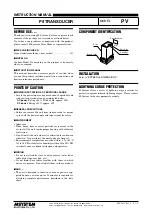
SITRANS P220 (7MF1567)
A5E03304437-AA, 09/2017
5
2.1.1
Laws and directives
Observe the safety rules, provisions and laws applicable in your country during connection, assembly and operation. These
include, for example:
●
National Electrical Code (NEC - NFPA 70) (USA)
●
Canadian Electrical Code (CEC) (Canada)
Further provisions for hazardous area applications are for example:
●
IEC 60079-14 (international)
●
EN 60079-14 (EC)
2.1.2
Conformity with European directives
The CE mark on the device is a sign of conformity with the following European directives:
Electromagnetic compatibility EMC
2014/30/EU
Directive of the European Parliament and of the Council on the harmonisation of the
laws of the Member States relating to electromagnetic compatibility.
Atmosphère explosible ATEX
2014/34/EU
Directive of the European Parliament and of the Council on the harmonisation of the
laws of the Member States relating to equipment and protective systems intended for
use in potentially explosive atmospheres.
The standards applied can be found in the EC declaration of conformity for the device.
WARNING
Improper device modifications
Risk to personnel, system and environment can result from modifications to the device, particularly in hazardous areas.
•
Only carry out modifications that are described in the instructions for the device. Failure to observe this requirement
cancels the manufacturer's warranty and the product approvals.
2.2
Requirements for special applications
Due to the large number of possible applications, each detail of the described device versions for each possible scenario
during commissioning, operation, maintenance or operation in systems cannot be considered in the instructions. If you need
additional information not covered by these instructions, contact your local Siemens office or company representative.
Note
Operation under special ambient conditions
We highly recommend that you contact your Siemens representative or our application department before you operate the
device under special ambient conditions as can be encountered in nuclear power plants or when the device is used for
research and development purposes.
2.3
Use in hazardous areas
Qualified personnel for hazardous area applications
Persons who install, connect, commission, operate, and service the device in a hazardous area must have the following
specific qualifications:
●
They are authorized, trained or instructed in operating and maintaining devices and systems according to the safety
regulations for electrical circuits, high pressures, aggressive, and hazardous media.
●
They are authorized, trained, or instructed in carrying out work on electrical circuits for hazardous systems.
●
They are trained or instructed in maintenance and use of appropriate safety equipment according to the pertinent safety
regulations.
Summary of Contents for SITRANS P220
Page 1: ...1 English 3 Deutsch 20 Français 37 ...
Page 2: ......






































